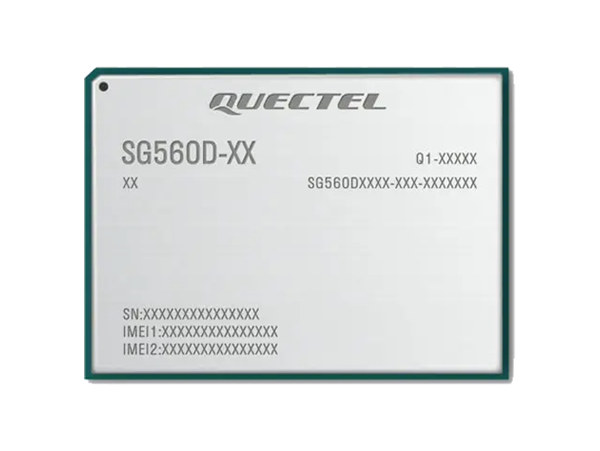Quectel SG560D is a 5G Sub-6GHz & WiFi 6E module for AIoT applications that runs Android 12 on a Qualcomm QCM6490 SoC with an octa-core Kryo 670 64-bit Arm CPU and a Qualcomm Adreno 643L GPU.
The SG560D module is equipped with 4GB LPDDR4X RAM and 64GB UFS storage by default, supports up to 2520×1080 MIPI display at a refresh rate of 144Hz, and can deliver up to 14 TOPS for AI inference.
Quectel SG560D key features and specifications:
- SoC – Qualcomm QCM6490 octa-core processor with one Kryo 670 Gold plus high-performance core up to 2.7 GHz, 3x Kryo Gold cores at 2.4 GHz, 4x Kryo Silver low-power cores @ 1.9 GHz, Adreno 643L GPU, 6th gen AI Engine delivering up to 14 TOPS, up to 4Kp30 H.265/H.264 video encode, 4Kp60 video decode; 6nm process.
- System Memory – 4GB LPDDR4X by default
- Storage – 64GB UFS flash by default
- Display – MIPI DSI interface up to 2520×1080 @ 144 Hz; touch panel interface
- Wireless connectivity
- Cellular
- 5G sub-6GHz support, backward compatible with global 4G LTE and 3G WCDMA networks
- 5G standalone (SA) and non-standalone (NSA)
- 4×4 MIMO download, 2×2 MIMO uplink
- Max. downlink: 2.5Gbps
- Max. uplink: 900Mbps
- Wi-Fi – WiFi 6E bands of 2.4 GHz, 5 GHz and 6 GHz, dual-band simultaneous (DBS), Wi-Fi 2×2 MU-MIMO
- Bluetooth – Bluetooth 5.2
- GNSS – GPS, GLONASS, BDS, NavIC, Galileo, QZSS, SBAS
- Multi-region variants with
- SG560D-EU for EMEA
- SG560D-NA for North America
- SG560D-CN for China
- SG560D-WF for worldwide use
- Cellular
- Peripherals – 2x USB, multiple PCIe, UART, I2S, SPI, LCM, camera, etc…
- Dimensions – 56.5 x 42.5 x 2.95mm (LGA module)
- Weight – 17.5 grams
- Temperature Range – -35°C to +75°C
While Quectel SG520D currently runs Android 12, the company promised a long life span with availability at least until 2028, and the module should get future upgrades for Android 13, Android 14, and Android 15. It is suitable for M2M and AIoT applications ranging from video conferencing systems, live streaming devices, gaming, robots, drones, AR/VR, and intelligent retail smart gateways and CPEs.
The 5G & WiFi 6E module was announced at Embedded World 2022, but the company did not provide availability and pricing information. More details may be found on the product page and press release.
Thanks to TLS for the tip.

Jean-Luc started CNX Software in 2010 as a part-time endeavor, before quitting his job as a software engineering manager, and starting to write daily news, and reviews full time later in 2011.
Support CNX Software! Donate via cryptocurrencies, become a Patron on Patreon, or purchase goods on Amazon or Aliexpress




